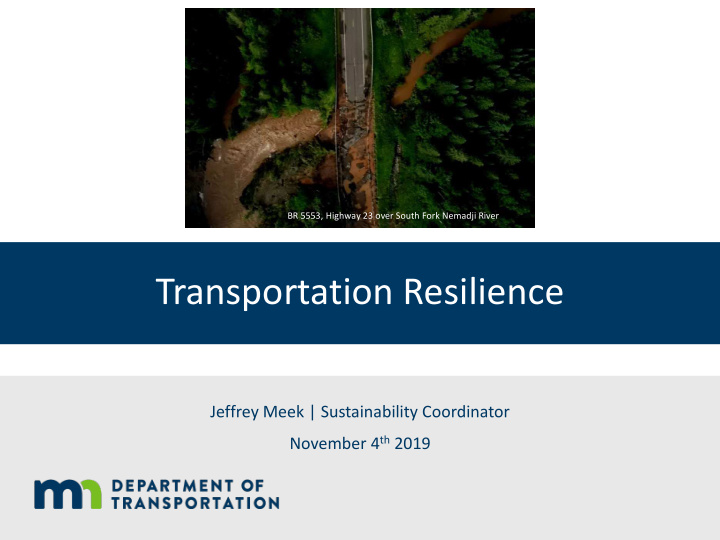



BR 5553, Highway 23 over South Fork Nemadji River Transportation Resilience Jeffrey Meek | Sustainability Coordinator November 4 th 2019
Overview • Federal Climate Resilience • Pilot Corridor Resilience Assessment • Current MnDOT practices that build climate resilience • Where MnDOT is headed • Vulnerability Assessment • Integration of Climate Vulnerability • Collaborative Projects
Resilience at the Federal Level • Senate Bill, America’s Transportation Infrastructure Act • AASHTO is aware of the need – MnDOT is part of the Steering committee • MN FHWA has Identified resilience as a risk to MnDOT • Corridor Resilience Assessment on TH52 (built from work in CO and UT) • Peer Exchange with other state DOTs
Updates TRB and NCHRP • NCHRP Synthesis 527: Resilience in Transportation Planning, Engineering, Management, Policy, and Administration, which documents resilience efforts and how they are organized, understood, and implemented within transportation agencies’ core functions and services. • NCHRP 20-59(54,55): Transportation System Resilience: Research Roadmap and White Papers; CEO Primer & Engagement • NCHRP 08-36/Task 146: Economic Resilience and Long-Term Highway/Transportation Infrastructure Investment, which developed an approach for incorporating resilience into transportation planning and assessment. • FHWA-HEP-17-082: Synthesis of Approaches for Addressing Resilience in Project Development • TRB Transportation Resilience Conference November 2019
MnDOT Resilience Practices Program Area Current Practices • Flash Flood VA and Extreme Flood VA Planning • Slope Stabilization Guide and Slope VA (multi-phased) • Bridge Manual (draft language) Design and • MN AOP Guide Environmental • Geomorphic Design Review • Stormwater Erosion Control Construction • State Flood Mitigation Program • Sustainable Pavements • Living Snow Fences Maintenance & • Salt Management Operations • Native and Resilient Plants • On-site Solar Energy • Asset Management • State Aid Betterment Emergency • Emergency Management and Response Response • Advancing Transportation Equity Overarching • Active Transportation and Complete Streets Initiatives • EV and EV Infrastructure
Example of Practice with Resilience Co-benefits • New Aquatic Organism Passage guidance • “What’s good for the fish is good for the climate”
Example of Practice with Resilience Co-benefits Overview of Traditional VS Geomorphic Design Approach
Ongoing Projects Climate change increases infrastructure vulnerability • Ongoing Extreme Flood VA will result in climate projections and a formula for analyzing asset vulnerability • Incorporate findings into BRIM and TAMS • Use findings to update design guidance
Ongoing Projects Continued • Social Vulnerability – climate adaptation benefits of reducing vulnerability • Betterment justification BR 5553, Highway 23 over South Fork Nemadji River - Develop policy or guidance on how to use climate vulnerability assessment findings to supplement betterment justifications (example)
Potential Resilience Collaborations Projects with Resilience Co-benefits • Compost as stormwater mitigation, and sequester carbon • Increase/improve use of vegetation to stabilize slopes Research Projects • Better downscaled climate data • Change in Freeze/Thaw cycles
Thank you Jeffrey Meek jeffrey.meek@state.mn.us
Extra Slides
Shift in Average Annual Precipitation
Shift in Average Annual Winter Low
Climate Change Impacts on Transportation Likelihood this will Climate Impacts change in MN over Potential Negative Implications for the Transportation System the next 20 years Slope failures and erosion (More mudslides, sink holes, road bed failure) Increased large-scale river flooding and localized flooding (bridge scour, roadway Heavy Precipitation / Very High erosion, inundation, construction disruption, etc.) More frequent and extensive inundation of low-lying areas (both temporary and Flooding permanent) Increase in overnight icing and in freeze/thaw cycles, leading to reduced pavement Very High Warmer Winters conditions and life cycles length Increase in average winter precipitation and more extreme precipitation New Species Soil erosion from vegetation loss Ranges Increase in invasive species populations High (mainly due to Wetland site failure warmer winters) Roadside vegetation stress and increases soil erosion Drought Medium Low stream and ground water flow Pavement and rail buckling Increase in vehicles overheating and electrical system malfunctions High Heat Medium-low Limitations on construction hours Immediate and significant threat to human safety Wildfires Low Increased risk of future flooding and slope failure Severe wind-related road closures, blown-down trees, signs Low Severe Wind
Climate Resilience
Example of How Climate Change Shifts Practices
Review of Other State DOTs • Vulnerability Assessment is the critical first step • Select climate projections • District-level adaptation plans (Caltrans) • State Adaptation Plan has helped other DOTs advance efforts • Resilience Hub – having centralized location for all related info advances work more quickly and accelerates collaboration (ex: resilientma.org)
Gaps and Opportunities Adaptation Action Status Action Description Complete System-wide In Progress Develop a set of climate projections and use assess Climate Vulnerability infrastructure vulnerability using them. Assessment Incorporate findings into Planned Integrate findings of the vulnerability assessments Asset Management into asset management (BRIM and TAMS) Update Design Guidelines Planned Review design guidelines using climate projections and incorporate changes to maintain performance into the future Protect Environmental In Progress Improve metrics for vulnerable population to Justice and Vulnerable incorporate it into decision-making Populations Downscaled Climate Data Not Allows for more detailed and region-specific climate started forecasting. MnDOT play a support role Actions with Adaptation In Progress Identify, support, and pilot projects with potential Co-benefits to increase resilience Resilience Research In Progress Continue to develop state specific research to address data and information gaps
Resilience Co-Benefits • Social Vulnerability – climate adaptation benefits of reducing vulnerability • Compost as stormwater mitigation, and sequester carbon • Increase/improve use of vegetation to stabilize slopes
Summary of Next Steps • MnDOT is doing a lot! • Complete the Extreme Flood Vulnerability Assessment and develop set of climate projections • Incorporate the findings into BRIM and TAMS • Update Design Guidelines: review current design guidelines and identify where climate projections can be incorporated • Improve the use of social vulnerability in decision making • Gather feedback on the district reports • Establish EJ and Social Vulnerability metrics that are consistent and inclusive, and incorporate into decision-making processes • Pilot Corridor Resilience Assessment
Recommend
More recommend